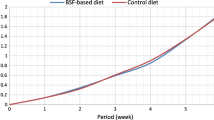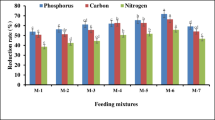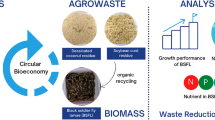Abstract
The anaerobic decomposition of coconut endosperm waste (CEW), residue derived from cooking, has been insidiously spewing greenhouse gasses. Thus, the bioconversion of CEW via in situ fermentation by exo-microbes from commercial Rid-X and subsequent valorization by black soldier fly larvae (BSFL) was the primary objective of the current study to gain sustainable larval lipid and protein. Accordingly, various concentrations of exo-microbes were separately homogenized with CEW to perform fermentation amidst feeding to BSFL. It was found that 2.50% of exo-microbes was the threshold amount entailed to assuage competition between exo-microbes and BSFL for common nutrients. The presence of remnant nutrients exuded from the fermentation using 2.50% of exo-microbes was confirmed to promote BSFL growth measured as maximum larval weight gained and growth rate. Although the BSFL could accumulate the highest protein (16 mg/larva) upon feeding with CEW containing 2.50% of exo-microbes, more lipid (13 mg/larva) was stored in employing 0.10% of exo-microbes because of minimum loss to metabolic processes while prolonging the BSFL in its 5th instar stage.



Similar content being viewed by others
References
Abdul Khalil HPS, Siti Alwani M, Mohd Omar AK (2006) Chemical composition, anatomy, lignin distribution and cell wall structure of Malaysian plant waste fibers. Bioresources 1:220–232
Albuquerque TA, Zurek L (2014) Temporal changes in the bacterial community of animal feces and their correlation with stable fly oviposition, larval development, and adult fitness. Front Microbiol 5:590
Arquier N, Géminard C, Bourouis M, Jarretou G, Honegger B, Paix A, Léopold P (2008) Drosophila ALS regulates growth and metabolism through functional interaction with insulin-like peptides. Cell Metab 7:333–338
Bulak P, Polakowski C, Nowak K, Waśko A, Wiącek D, Bieganowski A (2018) Hermetia illucens as a new and promising species for use in entomoremediation. Sci Total Environ 633:912–919
Cai M, Hu R, Zhang K, Ma S, Zheng L, Yu Z, Zhang J (2018) Resistance of black soldier fly (Diptera: Stratiomyidae) larvae to combined heavy metals and potential application in municipal sewage sludge treatment. Environ Sci Pollut Res 25:1559–1567
Chapman RF (2013) The insects: structure and function. Cambridge University Press, New York
Colombani J, Raisin S, Pantalacci S, Radimerski T, Montagne J, Léopold P (2003) A nutrient sensor mechanism controls Drosophila growth. Cell 114:739–749
de Carvalho MJA, Mirth CK (2017) Food intake and food choice are altered by the developmental transition at critical weight in Drosophila melanogaster. Anim Behav 126:195–208
Douglas AE (2010) The symbiotic habit. Princeton University Press, New Jersey
Finke MD (2013) Complete nutrient content of four species of feeder insects. Zoo Biol 32:27–36
Gao Q, Wang X, Wang W, Lei C, Zhu F (2017) Influences of chromium and cadmium on the development of black soldier fly larvae. Environ Sci Pollut Res 24:8637–8644
Géminard C, Rulifson EJ, Léopold P (2009) Remote control of insulin secretion by fat cells in Drosophila. Cell Metab 10:199–207
Giannetto A, Oliva S, Ceccon Lanes CF, de Araújo Pedron F, Savastano D, Baviera C, Parrino V, Lo Paro G, Spanò NC, Cappello T, Maisano M, Mauceri A, Fasulo S (2020) Hermetia illucens (Diptera: Stratiomydae) larvae and prepupae: biomass production, fatty acid profile and expression of key genes involved in lipid metabolism. J Biotechnol 307:44–54
Gold M, Tomberlin JK, Diener S, Zurbrügg C, Mathys A (2018) Decomposition of biowaste macronutrients, microbes, and chemicals in black soldier fly larval treatment: a review. Waste Manag 82:302–318
Kaza S, Yao L, Bhada-Tata P, Van Woerden F (2018) At a Glance: A Global Picture of Solid Waste Management. In: What a Waste 2.0: A Global Snapshot of Solid Waste Management to 2050. International Bank for Reconstruction and Development / the World Bank, Washington, DC, pp 17–38
Leong SY, Kutty SRM, Malakamad A, Tan CK (2016) Feasibility study of biodiesel production using lipids of Hermetia illucens larva fed with organic waste. Waste Manag 47:84–90
Li Q, Zheng L, Qiu N, Cai H, Tomberlin JK, Yu Z (2011) Bioconversion of dairy manure by black soldier fly (Diptera: Stratiomyidae) for biodiesel and sugar production. Waste Manag 31:1316–1320
Lim J-W, Mohd-Noor S-N, Wong C-Y, Lam M-K, Goh P-S, Beniers J, Oh W-D, Jumbri K, Ghani NA (2019) Palatability of black soldier fly larvae in valorizing mixed waste coconut endosperm and soybean curd residue into larval lipid and protein sources. J Environ Manag 231:129–136
Moh YC, Manaf LA (2014) Overview of household solid waste recycling policy status and challenges in Malaysia. Resour Conserv Recycl 82:50–61
Mohd-Noor S-N, Wong C-Y, Lim J-W, Uemura Y, Lam M-K, Ramli A, Bashir MJ, Tham L (2017) Optimization of self-fermented period of waste coconut endosperm destined to feed black soldier fly larvae in enhancing the lipid and protein yields. Renew Energ 111:646–654
National Solid Waste Management Department (2018) Food waste management development plan for industry, commercial and institution sector (2016–2026). Ministry of Housing and Local Government. https://jpspn.kpkt.gov.my/resources/index/user_1/Sumber_Rujukan/pelan_pembangunan_sisa-makanan/Food_waste_management_dev_plan_for_industry_commersial_and%20institution_sector.pdf. Accessed 15 March 2020
Newton G, Sheppard D, Watson D, Burtle G, Dove C, Tomberlin J, Thelen E The black soldier fly, Hermetia illucens, as a manure management/resource recovery tool. In: Symposium on the state of the science of Animal Manure and Waste Management, 2005. Semantic Scholar, pp 5–7
Nordentoft S, Fischer C, Bjerrum L, Heckmann L, Hald B (2017) Reduction of Escherichia coli, Salmonella Enteritidis and Campylobacter jejuni in poultry manure by rearing of Musca domestica fly larvae. J Insects Food Feed 3:145–153
Okamoto N, Yamanaka N (2015) Nutrition-dependent control of insect development by insulin-like peptides. Curr Opin Insect Sci 11:21–30
Oliwit AT, Cayetano RDA, Kumar G, Kim JS, Kim S-H (2019) Comparative evaluation of biochemical methane potential of various types of Ugandan agricultural biomass following soaking aqueous ammonia pretreatment. Environ Sci Pollut Res 1–11
Proc K, Bulak P, Wiącek D, Bieganowski A (2020) Hermetia illucens exhibits bioaccumulative potential for 15 different elements – implications for feed and food production. Sci Total Environ 723:138125
Qi X, Li Z, Akami M, Mansour A, Niu C (2019) Fermented crop straws by Trichoderma viride and Saccharomyces cerevisiae enhanced the bioconversion rate of Musca domestica (Diptera: Muscidae). Environ Sci Pollut Res 26:29388–29396
Rehman K et al (2017) Cellulose decomposition and larval biomass production from the co-digestion of dairy manure and chicken manure by mini-livestock (Hermetia illucens L.). J Environ Manag 196:458–465
Rodrigues MA, Martins NE, Balancé LF, Broom LN, Dias AJ, Fernandes ASD, Rodrigues F, Sucena É, Mirth CK (2015) Drosophila melanogaster larvae make nutritional choices that minimize developmental time. J Insect Physiol 81:69–80
Shin SC, Kim S-H, You H, Kim B, Kim AC, Lee K-A, Yoon J-H, Ryu J-H, Lee W-J (2011) Drosophila microbiome modulates host developmental and metabolic homeostasis via insulin signaling. Science 334:670–674
Storelli G, Defaye A, Erkosar B, Hols P, Royet J, Leulier F (2011) Lactobacillus plantarum promotes Drosophila systemic growth by modulating hormonal signals through TOR-dependent nutrient sensing. Cell Metab 14:403–414
Vakalis S, Moustakas K, Benedetti V, Cordioli E, Patuzzi F, Loizidou M, Baratieri M (2019) The “COFFEE BIN” concept: centralized collection and torrefaction of spent coffee grounds. Environ Sci Pollut Res 26:35473–35481
Wang X, Gao Q, Liu X, Wang X-P, Lei C, Sayed WA, Zhu F (2018) Metallothionein in Hermetia illucens (Linnaeus, 1758) larvae (Diptera: Stratiomyidae), a potential biomarker for organic waste system. Environ Sci Pollut Res 25:5379–5385
Wong C-Y, Rosli S-S, Uemura Y, Ho Y-C, Leejeerajumnean A, Kiatkittipong W, Cheng C-K, Lam M-K, Lim J-W (2019) Potential protein and biodiesel sources from black soldier Fly larvae: insights of larval harvesting instar and fermented feeding medium. Energies 12:1570
Wong C-Y, Lim J-W, Chong F-K, Lam M-K, Uemura Y, Tan W-N, Bashir M-J-K, Lam S-M, Sin J-C, Lam S (2020) Valorization of exo-microbial fermented coconut endosperm waste by black soldier fly larvae for simultaneous biodiesel and protein productions. Environ Res 185:109458
Yin S, Li G, Liu M, Wen C, Zhao Y (2018) Biochemical responses of the Protaetia brevitarsis Lewis larvae to subchronic copper exposure. Environ Sci Pollut Res 25:18570–18578
Zhao Y, Wang W, Zhu F, Wang X, Wang X, Lei C (2017) The gut microbiota in larvae of the housefly Musca domestica and their horizontal transfer through feeding. AMB Express 7:147
Zheng L, Hou Y, WuLi YS, Li Q, Yu Z (2012) Biodiesel production from rice straw and restaurant waste employing black soldier fly assisted by microbes. Energy 47:225–229
Funding
Financial supports from Yayasan Universiti Teknologi PETRONAS via YUTP-FRG with the cost center of 015LC0-126, Ministry of Education Malaysia under HICoE with the cost center of 015MA0-052, and The Murata Science Foundation with the cost center of 015ME0-104 are gratefully acknowledged.
Author information
Authors and Affiliations
Corresponding author
Ethics declarations
Conflict interests
The authors declare that they have no conflict of interests.
Additional information
Responsible editor: Ta Yeong Wu
Publisher’s note
Springer Nature remains neutral with regard to jurisdictional claims in published maps and institutional affiliations.
Rights and permissions
About this article
Cite this article
Hasnol, S., Lim, J.W., Wong, C.Y. et al. Liminal presence of exo-microbes inoculating coconut endosperm waste to enhance black soldier fly larval protein and lipid. Environ Sci Pollut Res 27, 24574–24581 (2020). https://doi.org/10.1007/s11356-020-09034-2
Received:
Accepted:
Published:
Issue Date:
DOI: https://doi.org/10.1007/s11356-020-09034-2




